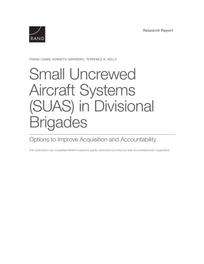Small Uncrewed Aircraft Systems (SUAS) in Divisional Brigades
Options to Improve Acquisition and Accountability
ResearchPublished Apr 8, 2025
Options to Improve Acquisition and Accountability
ResearchPublished Apr 8, 2025

The authors assessed the implications of integrating additional Group 1 and 2 uncrewed aircraft systems (UASs) for reconnaissance, fires, and other purposes below the division echelon. They derived implications for institutional and unit training, training support, and other institutional functions needed for success, such as how small UASs (SUASs) are acquired and accounted for and support functions needed for large-scale combat operations with a peer competitor.
This research was prepared for the United States Army and conducted within the Forces and Logistics Program of RAND Arroyo Center.
This publication is part of the RAND research report series. Research reports present research findings and objective analysis that address the challenges facing the public and private sectors. All RAND research reports undergo rigorous peer review to ensure high standards for research quality and objectivity.
This document and trademark(s) contained herein are protected by law. This representation of RAND intellectual property is provided for noncommercial use only. Unauthorized posting of this publication online is prohibited; linking directly to this product page is encouraged. Permission is required from RAND to reproduce, or reuse in another form, any of its research documents for commercial purposes. For information on reprint and reuse permissions, please visit www.rand.org/pubs/permissions.
RAND is a nonprofit institution that helps improve policy and decisionmaking through research and analysis. RAND's publications do not necessarily reflect the opinions of its research clients and sponsors.